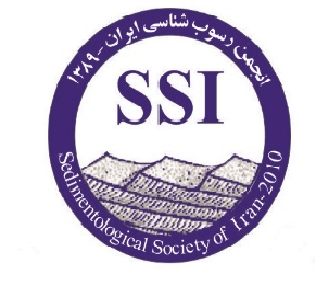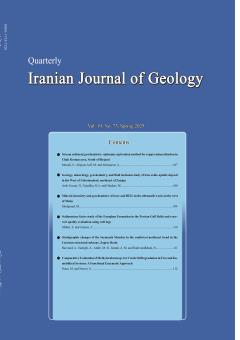Mineral chemistry and geochemistry of trace and rare earth elements in the ultramafic rocks of west of Maku
Subject Areas :
1 -
Keywords: Ophiolite, Rare earth elements pattern, Serpentinite, Crystal chemistry, Maku,
Abstract :
Late Cretaceous ultramafic rocks of the Neo-Tethyan ophiolite are located in the western Maku near the Iran-Turkey border as small, scattered bodies in vast areas. This part of Iran's territory belongs to the South Armenian Block (SAB), is Gondwanan, and is near the northern Neo-Tethyan suture. This study is focused on rock classification, residual phase composition, and mantle rock formation setting, using exact field relation observation, crystal chemistry studies, and whole rock chemistry accompanied by trace and rare earth elements investigations. The studied rocks were highly serpentinized, Ca-poor, and hydrated. These mantle rocks experienced a high degree of partial melting and were completely depleted from the incompatible elements. Therefore, the abundance of them was measured using a special method. The main phases are forsterite, enstatite, diopside, and chromian-spinel which are seen in the chrysotile-lizarditic serpentinized matrix. The U-shape rare earth elements pattern of the western Maku serpentinites is recorded as crustal contamination evidence. Additionally, the studied ultramafic rocks of western Maku based on the whole rock chemistry, diagrams and relations between major oxide and trace elements belong to the subducted serpentinites group. Also, they practiced high refertilization values by fluid/rock interactions on them. Hence, the enrichment of fluid mobile elements (FMEs) such as U, Pb, and Sr results from secondary events occurring during exhumation.
آقانباتی، ع.، 1383. زمینشناسی ایران، انتشارات سازمان زمین¬شناسی کشور، تهران.
جلالت وکیل کندی، ص.، شاه پسندزاده، م.، هنرمند، م. و احمدی پور، ح.، 1398. الگوی ساختاری بخش خاوری توده پریدوتیتی ده شیخ، آمیزه افیولیتی اسفندقه، جنوب باختر ایران، فصلنامه زمینشناسی ایران، 13 (49): 49-61.
روستایی، م.، زمانی، ب.، نواب پور، پ. و مؤید، م.، 1393. بررسی ساز و کار و نئوتکتونیک زون گسله سیه چشمه- خوی، علوم زمین، 24 (96): 221-234.
مجرد، م.، 1401. پترولوژی گدازههای جوان ماکو-پلدشت: با نگاهی به توزیع اندازه بلورهای الیوین و حفرات، زمین¬شناسی کاربردی پیشرفته، 12 (4): 981-1000.
مجرد، م. و مؤید، م.، 1403. ژئوشیمی سرپانتینیتهای قطعه مرکزی خط درز نئوتتیس (از شمالغرب ایران تا زاگرس عراقی و شرق آناتولی)، فصلنامه زمین¬شناسی ایران، 18 (69): 49-66.
مجیدی، م.، 1385. ورقه 1:100000 سیه چشمه، سازمان زمین¬شناسی کشور. تهران.
نیکبخت، س.، بیابانگرد، ح. و باقری، س.، 1399. پترولوژی و ژئوشیمی افیولیت سیاه جنگل، شمالشرق آتشفشان تفتان، فصلنامه زمین¬شناسی ایران، 14 (56): 87-99.
Bellon, H. and Braud, J., 2003. Carbonate Sedimentary Environment, John Wiley, 360.
Cliff, R.A., Droop, G.T. and Rex, D., 1985. Alpine metamorphic in the south-east Tauern Window. Journal of Metamorphic Geology, 3(4), 403-415.
Bach, W. and Klein, F., 2009. The petrology of seafloor rodingites: insights from geochemical reaction path modelling. Lithos, 112, 103–117.
Barnes, J. D., Eldam, R., Lee, C. T. A., Errico, J. C., Loewy, S. and Cisneros, M., 2013. Petrogenesis of serpentinites from the Franciscan Complex, western California, USA. Lithos, 178, 143–157. https://doi.org/10. 1016/j.lithos.2012.12.018.
Barrier, E. and Vrielynck, B., 2008. Paleotectonic maps of the Middle East – Atlas of 14 maps, in: Middle East Basin Evolution Programme.
Berberian, M. and King, G.C.P., 1981. Towards a paleogeography and tectonic evolution of Iran. Canadian Journal of Earth Sciences, 18, 210–265. https://doi.org/10.1139/e81-019.
Berberian, M., 1997. Tectonic and Fault Reevaluation Study of the Bushehr Nuclear Power Plant Site. Khak-e Khub, Atomic Energy Organization of Iran (AEOI), April 1997, 98 pages, 5 Maps and Figures, 48 Plates in 13 Chapters (in English).
Dilek, Y. and Furnes, H., 2014. Ophiolites and their origins. Elements, 10, 93–100.
Deschamps, F., Godard, M., Guillot, S. and Hattori, K., 2013, Geochemistry of subduction zone serpentinites. A review: Lithos, 178, 96-127.
Ewart, A., Collerson, K. D., Regelous, M., Wendt, J. I. and Niu, Y., 1998. Geochemical evolution within the Tonga–Kermadec–Lau arc–backarc system: the role of varying mantle wedge composition in space and time. Journal of Petrology, 39, 331–368.
Green II, H.W., 2007. Shearing instabilities accompanying high-pressure phase transformations and the mechanics of deep earthquakes. Proceedings of the National Academy of Sciences, 104, 9133–9138.
Grosjean, M., Moritz, R., Rezeau, H., Hovakimyan, S., Ulianov, A., Chiaradia, M. and Melkonyan, R., 2022. Arabia-Eurasia convergence and collision control on Cenozoic juvenile K-rich magmatism in the South Armenian block. Lesser Caucasus. Earth-Science Reviews, 226. https://doi.org/10.1016/j. earscirev.2022.103949 103949.
Gruau, G., Bernard-Griffiths, J. and Lecuyer, C., 1998. The origin of U-shaped rare earth patterns in ophiolite peridotites: Assessing the role of secondary alteration and melt/rock reaction. Geochimica et Cosmochimica Acta, 62, 21/22: 3545–3560.
Huang, R. F., Sun, W. D., Ding, X. and Wang, Y. R., 2013. Mechanism for serpentinization of mafic and ultramafic rocks and the potential of mineralization. Acta Petrologica Sinica, 29(12): 4, 336–4,348 (in Chinese with English abstract).
Kochergina, Y. V., Ackerman, L., Erban, V., Matusiak-Małek, M., Puziewicz, J., Halodová, P. and Magna, T., 2016. Rhenium–osmium isotopes in pervasively metasomatized mantle xenoliths from the Bohemian Massif and implications for the reliability of Os model ages. Chemical Geology, 430, 90–107. https://doi.org/10.1016/j.chemgeo.2016.03.020.
Kodolányi, J., Pettke, T., Spandler, C., Kamber, B. S. and Gméling, K., 2012. Geochemistry of ocean floor and fore-arc serpentinites: Constraints on the ultramafic input to subduction zones. Journal of Petrology, 53(2), 235–270. https://doi.org/10.1093/petrology/egr058.
Li, X. P., Rahn, M. and Bucher, K., 2004. Serpentinites of the Zermatt-Saas ophiolite complex and their texture evolution. Journal of Metamorphic Geology, 22, 159–177. https://doi.org/10.1111/j.1525-1314.2004. 00503.x
Modjarrad, M., Whitney, D.L. and Omrani, H., 2024a. Petrologic evolution of the Gysian ophiolitic serpentinites, NW Iran. Acta Geochim, https://doi.org/10.1007/s11631-024-00682-6
Modjarrad, M. Whitney, D.L. and Omrani, H., 2024b. The P–T–X conditions of staurolite-garnet metabasites, NW Iran: implications for metamorphism during Arabia-Eurasia collision. Journal of Asian Earth sciences: X, https://doi.org/10.1016/j.jaesx.2024.100175
Modjarrad, M., Uysal, İ., Moghadam, H.S., Demir, Y. and Müller, D., 2025. Geochemical insights and petrogenetic processes of ophiolitic fragments from the Avajiq and Silvana: Implications for Neo-Tethyan Evolution in Northwest Iran. International Geology Reviews, https://doi.org/10.1080/00206814.2025.2453979
Mohajjel, M., and Fergusson, C.L., 2000. Dextral transpression in Late Cretaceous continental collision, Sanandaj-Sirjan Zone, western Iran. Journal of Structural Geology, 22, 1125–1139. https://doi.org/10.1016/S0191-8141(00)00023-7.
Mohammadi, A., Burg, J.P. and Guillong, M., 2020. The Siah Cheshmeh-Khoy-Misho-Tabriz fault (NW Iran) is a cryptic neotethys suture: evidence from detrital zircon geochronology, Hf isotopes, and provenance analysis, International Geology Review, https://doi.org/10.1080/00206814.2020.1845992
Neill, I., Meliksetian, Kh., Allen, M.B., Navarsardyan, G. and Karapetyan, S., 2013. Pliocene– Quaternary volcanic rocks of NW Armenia: magmatism and lithospheric dynamics within an active orogenic plateau. Lithos, 180–181, 200–215
Nikogosian, I.K., Bracco Gartner, A.J.J., Mason, P.R.d., van Hinsbergen, D.J.J., Kuiper, K.F., Kirscher, U., Matveev, S., Grigoryan, A., Grigoryan, E., Israyelyan, A., van Bergen, M.J., Koornneef, J.M., Wijbrans, J.R., Davies, G.R. and Meliksetian, K., 2023. The South Armenian Block: Gondwanan origin and Tethyan evolution in space and time. Gondwana Research, 121, 168–195. https://doi.org/10.1016/j.gr.2023.03.023
Niu, Y., Langmuir, C.H. and Kinzler, R.J., 1997. The origin of abyssal peridotites: a new perspective. Earth and Planetary Science Letters, 152, 251–265.
Niu, Y., 1999. Comments on some misconceptions in igneous/ experimental petrology and methodology: a reply. Journal of Petrology, 40, 1195–1203
Niu, Y., Gilmore, T., Mackie, S., Greig, A. and Bach, W., 2002. Mineral chemistry, whole-rock compositions and petrogenesis of ODP Leg 176 gabbros: data and discussion. Proceedings of the Ocean Drilling Program, Scientific Results, 176. 60. [Online] Available at http://www-odp.tamu.edu/publications/176_SR/chap_08/ chap_08.htm
Niu, Y. and O’Hara, M.J., 2003. The origin of ocean island basalts (OIB): a new perspective from petrology, geochemistry and mineral physics considerations. Journal of Geophysical Research, 108, 10.1029/ 2002JB002048, 19.
Niu, Y., 2004. Bulk-rock major and trace element compositions of abyssal peridotites: implications for mantle melting, melt extraction and post-melting processes beneath mid-ocean ridges. Journal of Petrology, 45, 2423–2458.
Parkinson, I.J. and Pearce, J.A., 1998. Peridotites from the Izu–Bonin–Mariana forearc (ODP Leg 125): evidence for mantle melting and melt–mantle interaction in a suprasubduction zone setting. Journal of Petrology, 39 (9), 1577–1618.
Paulick, H., Bach, W., Godard, M., De Hoog, J.C.M., Suhr, G. and Harvey, J., 2006. Geochemistry of abyssal peridotites (Mid-Atlantic Ridge, 15°20′N, ODP Leg 209): implications for fluid/rock interaction in slow spreading environments. Chemical Geology, 234, 179–210.
Pearce, J. A. and Robinson, P. T., 2010. The Troodos ophiolitic complex probably formed in a subduction initiation, slab edge setting. Gondwana Research, 18(1), 60–81. https://doi.org/10.1016/j.gr.2009.12.003
Pfeifer, H. R., 1990. Major and Trace Element Discrimination Diagrams to Determine Possible Protoliths of Orogenic Ultramafic Rocks. Universite de Lausanne.
Rolland, Y., Hässig, M., Bosch, D., Bruguier, O., Melis, R., Galoyan, G., Topuz, G., Sahakyan, L., Avagyan, A. and Sosson, M., 2020. The East Anatolia-Lesser Caucasus ophiolite: An exceptional case of large-scale obduction, synthesis of data and numerical modelling. Geosciences Frontiers, 11, 83–108. https://doi.org/10.1016/j. gsf.2018.12.009
Rudnick, R. L. and Fountain, D. M., 1995. Nature and composition of the continental crust: a lower crustal perspective. Review of Geophysics, 33, 267–309.
Rüpke, L.H., Morgan, J.P., Hort, M. and Connolly, J.A.D., 2004. Serpentine and the subduction zone water cycle. Earth and Planetary Science Letters, 223, 17–34.
Sun, S. S. and McDonough, W. F., 1989. Chemical and isotopic systematics of oceanic basalts: Implications for mantle composition and processes. In A. D. Saunders and M. J. Norry (Eds.), (42: 313–345). Magmatism in the Ocean Basins: Geological Society Special Publication. https://doi.org/10.1144/GSL.SP.1989.042.01.19
Taylor, S.R. and McLennan, S.M., 1985. The Continental Crust: Its composition and evolution; an examination of the geochemical record preserved in sedimentary rocks; Blackwell, Oxford. 312.
Uysal, İ., 2008. Platinum-group minerals (PGM) and other solid inclusions in the Elbistan–Kahramanmaras¸ mantle-hosted ophiolitic chromitites, south-eastern Türkiye: their petrogenetic significance. Turkish Journal of Earth Sciences, 17, 729–740.
Uysal, İ., Tarkian, M., Sadiklar, M.B., Zaccarini, F., Meisel, T., Garuti, G. and Heidrich, S., 2009. Petrology of Al- and Cr-rich ophiolitic chromitites from the Muğla, SW Türkiye: implications from composition of chromite, solid inclusions of platinum-group mineral, silicate, and base-metal mineral, and Os-isotope geochemistry. Contributions to Mineralogy and Petrology, 158, 659–674.
Uysal, İ., Akmaz, R.M., Kapsiotis, A., Demir, Y., Saka, S., Avcı, E. and Müller, D., 2015. Genesis and geodynamic significance of chromitites from the Orhaneli and Harmancık ophiolites (Bursa, NW, Türkiye) as evidenced by mineralogical and compositional data. Ore Geology Reviews, 65, 26–41.
Wakabayashi, J., 2017, Structural context and variation of ocean plate stratigraphy, Franciscan Complex, California: Insight into mélange origins and subduction-accretion processes. Progress in Earth and Planetary Science, 4:, 18, https://doi.org/10.1186/s40645-017-0132-y.
Whattam, S.A. and Stern, R.J., 2011. The ‘subduction initiation rule’: A key for linking ophiolites, intra-oceanic fore arcs, and subduction initiation. Contributions to Mineralogy and Petrology, 162, 1031–1045. doi:10.1007/s00410-011- 0638-z.
Whitney, D.L. and Evans, B.W., 2010. Abbreviations for names of rock-forming minerals. American Mineralogist, 95(1), 185-187.
Wu, K., Yuan, H. L., Lyu, N. and Zhang, L. P., 2020. The behavior of fluid mobile elements during serpentinization and dehydration of serpentinites in subduction zones. Acta Petrologica Sinica, 36(1), 141–153. (in Chinese with English abstract).
Xin, G.Y., Chu, Y., Su, B.X., Lin, W., Uysal, I. and Feng, Z.T., 2021. Rapid transition from MORB type to SSZ type oceanic crust generation following subduction initiation: insights from the mafc dikes and metamorphic soles in the Pozantı Karsantı ophiolite, SE Türkiye. Contributions to Mineralogy and Petrology, 176, 64 https://doi.org/10.1007/s00410-021-01821-5.
Zhang, Z., Xiao, W., Ji, W. and Majidifard, M.R., 2018, Geochemistry, zircon U-Pb and Hf isotope for granitoids, NW Sanandaj-Sirjan zone, Iran: Implications for Mesozoic-Cenozoic episodic magmatism during Neo-Tethyan lithospheric subduction. Gondwana Research, 62: 227-245. doi:10.1016/j.gr.2018.04.002.

